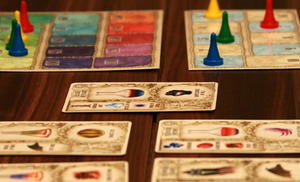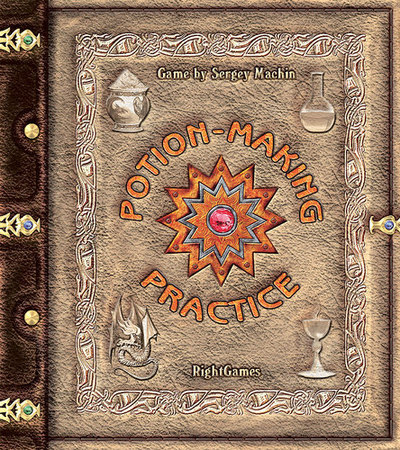
While Russia might not be well known for producing games, it can’t be denied that the country has had a huge impact on gaming in general, through the creation of a single game. During the time of the former Soviet Union, a computer game was created in Moscow that would forever change the face of gaming, making ripples in the world of video games, and board games alike. The computer game, originally programmed on the Soviet made Elekronika 60 minicomputer by computer engineer Alexey Pajitnov, was called Tetris.
Even though Tetris was released on computers and consoles in the mid 1980’s, its influence can be found even to this day in modern board games: from Knizia’s geometric manipulation game Fits, to David Sirlin’s Puzzle Bobble inspired deck builder, Puzzle Strike. It was due to this influential history, that I was very interested to see how the gaming landscape was developing in Russia, and if there were more hidden gems being cultivated there.
Russian publisher RightGames, has been making games for the Russian market for several years now, but has recently chosen to print a handful of its more successful games in English, and selling them directly to the English speaking market through their website www.russianboardgames.com. As of now, RightG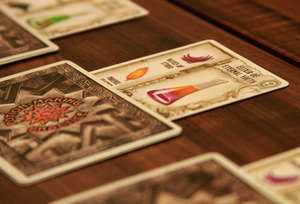 ames has translated four titles into English - Potion Making: Practice, Evolution, The Kingdoms of Crusaders, and The Enigma of Leonardo. Of this collection, the title that jumped out at me first, and that I am going to review here, is the alchemy themed card game Potion-Making: Practice, designed by Sergey Machin.
ames has translated four titles into English - Potion Making: Practice, Evolution, The Kingdoms of Crusaders, and The Enigma of Leonardo. Of this collection, the title that jumped out at me first, and that I am going to review here, is the alchemy themed card game Potion-Making: Practice, designed by Sergey Machin.
In Potion Making: Practice, players are compete to retrieve cards from a common stock, which they use to complete alchemical recipes. Players not only make the potions alluded to in the game’s title, but also talismans, powders, and a handful of mythological creatures. These different items are created by combining simple elements, or sometimes, more complex potions and powders that have been created during the game. After all of the cards have been played, the player with the most points is declared the winner.
Components:
Potion Making: Practice is beautifully illustrated. The choice of colors, layout, and illustrations on the cards make for a wonderfully thematic experience. The whole package offers a medieval alchemy theme, and the subject matter might evoke thoughts of current fantasy literature like Harry Potter. But, with the choice of vivid colors and combinations in the potions and illustrations, players could just as easily place themselves in the position of a wandering Romany (Gypsy), mixing love potions, and crafting secret magick trinkets during his travels.
The Box - The box for potion making practice is small, colorfully illustrated, and made of a thin cardstock. The box is open at one end, with a corrugated cardboard insert that slides out. The insert has two sections, one to hold the cards, and the other to hold the plastic scorekeeping markers. While the box is a bit flimsy, the insert works to keep it in shape, although I wouldn’t stack any heavy games on top of it, as it could crush easily. Since the box is made of lightweight material, and the games are shipped from Russia, the box is practical, as it will keep shipping costs down. While I would have preferred a more sturdy box, the components inside are what matters most to me.
The Manual - The manual is made up of a few full-color pages folded together. Potion Making: Practice is a simple game, and doesn’t contain many rules, so this presentation works out well. The English translation of the manual looks to have been made by someone who does not speak English as a primary language, and suffers from some awkward sentence structure that sometimes requires a re-read. But, for the most part, the manual is well laid out and clear in its delivery; two things that are more important than the occasional verb conjugation issues.
I actually find the occasional grammatical inconsistency endearing. It reminds me that the game I am playing comes from a place that most of my life was considered exotic, and impenetrable. While I am glad that changes in the political climate, and the advent of the 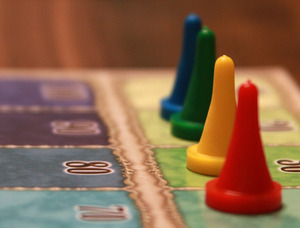 Internet are creating a world with less borders, and the younger generation may not understand the curious fascination I have with Russia, there was still something exciting about receiving a package in the mail from Moscow, covered in the foreign Cyrillic lettering found in the propaganda of my youth.
Internet are creating a world with less borders, and the younger generation may not understand the curious fascination I have with Russia, there was still something exciting about receiving a package in the mail from Moscow, covered in the foreign Cyrillic lettering found in the propaganda of my youth.
All in all, the manual is clearly written, and the rules simple enough that there should be little difficulty understanding them. The game may seem a little complicated after reading the rules, due to the different combination of potions and elements available, but playing through the game once should make everything crystal clear.
The Cards - The cards in Potion-Making Practice are printed on a flat cardstock, and appear to be die-cut. I would have liked to see a slightly more rugged build on the cards, as every card is manipulated at least once during each game, and I can foresee the cards becoming worn fairly quickly. Potion Making: Practice is definitely a candidate for card sleeves.
Where the cards lack in durability, though, they totally make up for in beauty; with some extremely unique, colorful, and evocative illustrations; and a wonderful color palette. The cards manage to be simple to read and understand, and the use of colors in the illustrations work as a kind of iconography to make the large number of different potions and magical items easily recognizable, even from across the table. This use of color may not be as effective for those who have color blindness, but each illustration also has text describing it, so it should remain accessible. There is a lot of detailed black and white artwork in the empty space of each card that cleverly separates the different areas of the card, and despite its detail, does not make the card feel too busy. Instead, this border art makes the cards feel like they are pages out of an old, hand-inked, medieval manuscript, and really help reinforce the theme.
Plastic Counters - Score is kept by moving small, colored plastic pawns along a pair of colorful cardstock tracks. The scoring tracks maintain the same colorful art style as the rest of the game, but the plastic pawns seem out of place. The angular, cone shaped pawns are cast in primary colors, and seem to clash with the elegant style and color palette of the other components in the game. They are functional, and good quality, but I quickly swapped mine out for a set of glass craft beads that seemed to fit the theme much better. Although a minor change, this really helped maintain immersion in the game.
Setup in Potion Making: Practice is very simple. The deck of cards is shuffled, four cards are placed face-up in the center of the table, and each player draws four cards to create his starting hand. Each player then chooses a color, and selects the two pawns he will use to denote his score on the scoring tracks.
The scoring track is made up of two separate paths: The first displays the numbers from 1-10, and the second shows numbers in increments of 10, starting with the number 10. When a player reaches 10 points on the smaller track he resets his pawn back to zero, and advances his pawn on the larger track. The player's score can be determined by adding the value of the two tracks together.
The Game:
Players in Potion Making: Practice compete to make potions by selecting ingredient cards from the center of the table, and pairing them with a “formula” card in their hand that lists specific ingredients needed to make the potion. The ingredient cards at the center of the table, called “elements” in game terminology, are available for use by anyone in the game, and as the game progresses, the elements available will change as players manipulate them.
A player turn consists of two simple steps: Draw a card, and play a card. That’s it. It’s through the way the cards combine, and interact, that gameplay progresses.
Every card in Potion Making: Practice serves double duty. First and foremost, every card can be used as an element - the basic ingredient used to make a potion. The element that the ca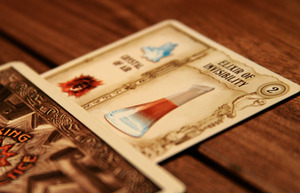 rd represents is depicted by a colorful illustration at the bottom of the card. Aside from being an element, most cards are formulas as well – recipes that a player can use to create a potion, or other magical artifact. There are also a limited handful of “spell” cards that add flavor to the game, by allowing the player to perform rule-breaking actions, such as swapping cards in play. The upper half of the card describes the formula or spell that the card represents.
rd represents is depicted by a colorful illustration at the bottom of the card. Aside from being an element, most cards are formulas as well – recipes that a player can use to create a potion, or other magical artifact. There are also a limited handful of “spell” cards that add flavor to the game, by allowing the player to perform rule-breaking actions, such as swapping cards in play. The upper half of the card describes the formula or spell that the card represents.
During a player’s turn he will draw a card from the deck, and then play a card to one of two places: either the center of the table, or in front of him. If a player has a formula in his hand, and the correct element cards needed to make that formula can be found in the center of the table, the player can remove the required elements from the table, and play the potion face up in front of him; placing the elements that he used to make the potion across it. By doing this, the player has created a potion, and scores points equal to the number in the upper right hand corner of the formula card. It’s important to note that a player never uses cards from his hand as ingredients for a potion, only elements from the center of the table.
However, if a player cannot, or chooses not to make a potion, he must play a card from his hand to the center of the table. A card played this way becomes an element, and can now be used by any of the other players to make their potions. Choosing which cards to play as elements and which cards to keep can be tricky, as there is some strategy to be found here. Since a formula can only be used if it is in your hand, it is in your best interest to hold on to higher scoring formulas. On the other hand, playing an element to the table that isn’t already present might give your opponents just what they need to make a potion that they have been saving in their hand. Choosing what to keep, and what to play can be a bit of a balancing act.
To add an additional layer of complexity to the game, there are some formulas that use other potions as ingredients. In fact, the more valuable the formula, the more complicated ingredients it requires. Since the cards in the center of the table are all elements, the only place to find potions are in front of the players. When making one of these more complicated potions, a player can use a completed potion from in front of himself, or any other player. When using one of these potions as an ingredient, it is removed from the 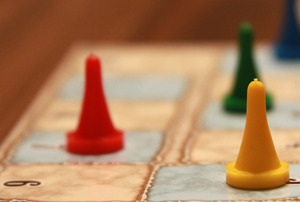 owning player's spread, and placed across the newly created potion, just like an element ingredient. The element cards that made up the ingredient potions are then returned to the center of the table, putting those elements back into play.
owning player's spread, and placed across the newly created potion, just like an element ingredient. The element cards that made up the ingredient potions are then returned to the center of the table, putting those elements back into play.
Like any potion, regardless of where the ingredients came from, the current player scores points for completing it. But, if another player’s potion was used as an ingredient, that player scores points as well – half of the value of the new potion. For this reason, it’s important to pick and choose which potions to make and use, as you can unintentionally help another player by using his potion as an ingredient.
Play continues, with potions being made, and elements added to the center of the table until all of the cards have been played. When this happens, the game is over, and the winner is declared as the player who has the most points.
Conclusion:
Potion Making: Practice is a light game, but not so light that it is tedious to play. The colorful, friendly artwork is inviting, and the information on the cards is non-intimidating, and accessible, making me wonder if this might work as an excellent gateway game for people who are new to hobby games. The mechanics and artwork meld together very well to make playing Potion Making: Practice as much an experience, as a game; it certainly speaks to the part of me that was always asking for a chemistry set as a child. The process of combining potions into more and more complicated creations feels very satisfying, and although there is luck to be found in the game, there is enough strategy that it doesn’t feel completely random.
That’s not to say that randomness doesn’t play a part in the game: it can sometimes feel like no matter what you do, you just can’t draw the cards you need – especially if you are drawing a lot of high level cards at the beginning of the game. But for the most part, much of the randomness can be mitigated by making strategic choices about what you play to the table, or keep in your hand.
While the game supports up to six players, it really hits its stride at four. With too many players, the landscape of the board can change drastically before a player's turn comes back around, and that has the potential to feel very chaotic. With lower player counts, however, there is 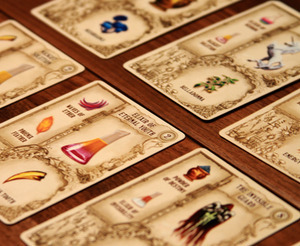 enough uncertainty to make risky decisions, without causing things to feel completely out of control.
enough uncertainty to make risky decisions, without causing things to feel completely out of control.
While the component and box quality of the game could have been a bit better, the wonderful artwork and compelling theme of the game really makes up for it in my eyes, allowing me to look past any inadequacies and embrace the game's core.
I also thought that the pacing of the game was very well designed. The process of using potions to make more complicated items gives the game a nice crescendo towards the end. Because a potion’s ingredients are returned to the table when it is used as an ingredient itself, more and more elements are introduced back to the table as the game progresses, quickening the rate that potions are created, and causing a great frantic tension at the game’s close.
The wonderful artwork and pitch perfect pacing make Potion Making: Practice a great casual, social game that can be enjoyed as filler, or with players of varying skill levels. While the inherent randomness in the game may turn off those looking for a more beefy strategy game, I feel that there is enough strategy and control in the decisions made to appease most gamers, and still remain accessible to those who just want to play a light game. If, like me, you find your gaming time split between casual family and experienced gamers, I would suggest Potion Making: Practice as a game that will succesfully bridge the gap, and find itself at home in either group.
